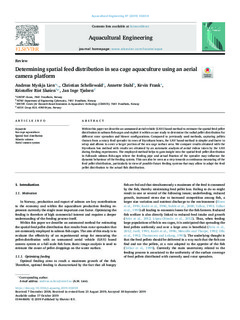| dc.contributor.author | Lien, Andreas Myskja | |
| dc.contributor.author | Schellewald, Christian | |
| dc.contributor.author | Stahl, Annette | |
| dc.contributor.author | Frank, Kevin | |
| dc.contributor.author | Skøien, Kristoffer Rist | |
| dc.contributor.author | Tjølsen, Jan Inge | |
| dc.date.accessioned | 2020-01-13T09:41:18Z | |
| dc.date.available | 2020-01-13T09:41:18Z | |
| dc.date.created | 2019-11-01T13:05:02Z | |
| dc.date.issued | 2019 | |
| dc.identifier.citation | Aquacultural Engineering. 2019, 87:102018 1-9. | nb_NO |
| dc.identifier.issn | 0144-8609 | |
| dc.identifier.uri | http://hdl.handle.net/11250/2635874 | |
| dc.description.abstract | Within this paper we describe an unmanned aerial vehicle (UAV) based method to estimate the spatial feed pellet distribution in salmon fish-cages and exploit it within a case study to determine the radial pellet distribution for different rotor spreaders and blower configurations. Compared to previously used methods, capturing pellets thrown from a rotary feed spreader in rows of Styrofoam boxes, the UAV based method is simpler and faster to setup and allows to cover a larger portion of the sea cage surface area. We compare results obtained with the Styrofoam box method with results we obtained by an automatic analysis of aerial videos taken by the UAV during feeding experiments. The employed method helps to gain insight into the spatial feed pellet distribution in full-scale salmon fish-cages where the feeding pipe and actual fixation of the spreader may influence the dynamic behaviour of the feeding system. This can also be seen as a step towards a continuous measuring of the feed pellet distribution, particularly in view of possible future feeding systems that may allow to adapt the feed pellet distribution to the actual fish distribution. | nb_NO |
| dc.language.iso | eng | nb_NO |
| dc.publisher | Elsevier | nb_NO |
| dc.rights | Attribution-NonCommercial-NoDerivatives 4.0 Internasjonal | * |
| dc.rights.uri | http://creativecommons.org/licenses/by-nc-nd/4.0/deed.no | * |
| dc.title | Determining spatial feed distribution in sea cage aquaculture using an aerial camera platform | nb_NO |
| dc.type | Journal article | nb_NO |
| dc.type | Peer reviewed | nb_NO |
| dc.description.version | publishedVersion | nb_NO |
| dc.source.pagenumber | 1-9 | nb_NO |
| dc.source.volume | 87:102018 | nb_NO |
| dc.source.journal | Aquacultural Engineering | nb_NO |
| dc.identifier.doi | 10.1016/j.aquaeng.2019.102018 | |
| dc.identifier.cristin | 1743256 | |
| dc.description.localcode | Copyright © 2019 by the authors. CC-BY-NC-ND license. | nb_NO |
| cristin.unitcode | 194,63,25,0 | |
| cristin.unitname | Institutt for teknisk kybernetikk | |
| cristin.ispublished | true | |
| cristin.fulltext | original | |
| cristin.qualitycode | 1 | |

